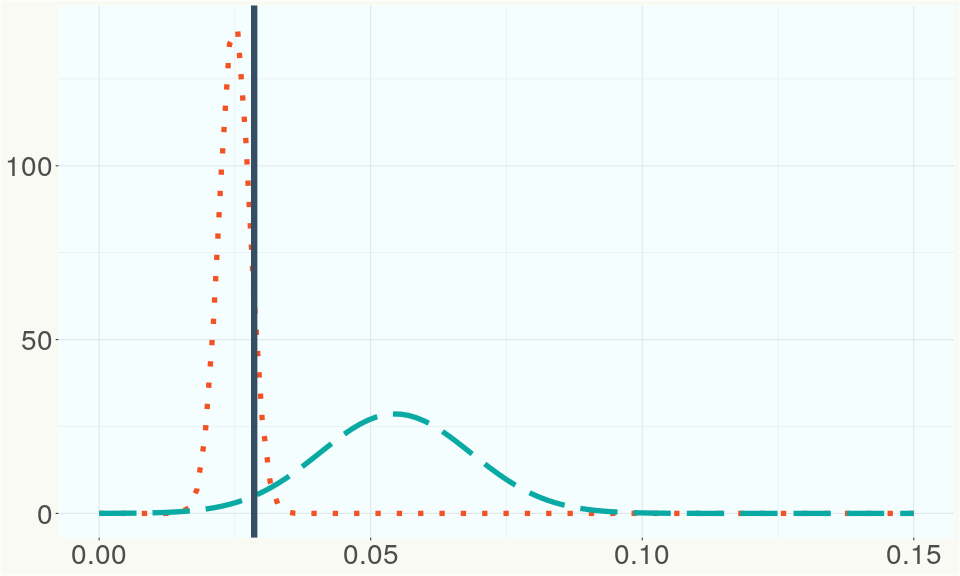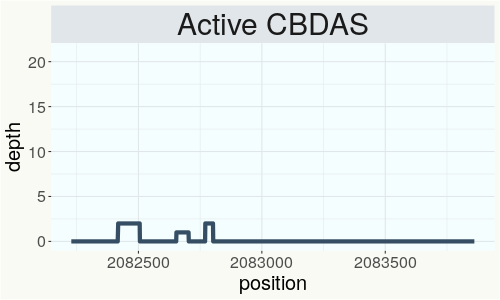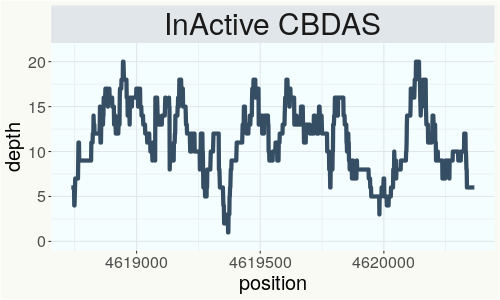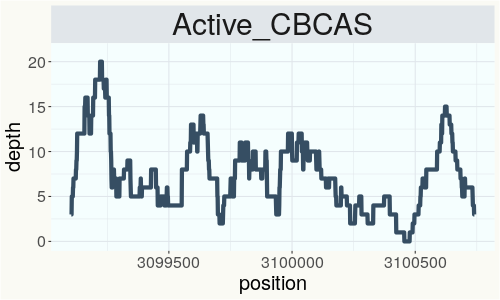CDSD
RSP 12929
Grower: Zamir Punja
General Information
- Sample Name
- CDSD - roots from veg plant
- Accession Date
- September 27, 2023
- Reported Plant Sex
- Female
- Report Type
- Whole-Genome Sequencing
- Microbiome
- Krona Plot
- Fungal Microbiome
- Krona Plot
- Bacterial Microbiome
- Krona Plot
- Viral Microbiome
- Krona Plot
The strain rarity visualization shows how distant the strain is from the other cultivars in the Kannapedia database. The y-axis represents genetic distance, getting farther as you go up. The width of the visualization at any position along the y-axis shows how many strains there are in the database at that genetic distance. So, a common strain will have a more bottom-heavy shape, while uncommon and rare cultivars will have a visualization that is generally shifted towards the top.
Chemical Information
Cannabinoid and terpenoid information provided by the grower.
Cannabinoids
No information provided.
Terpenoids
No information provided.
Genetic Information
- Plant Type
- Type I
File Downloads
The bell curve in the heterozygosity visualization shows the distribution of heterozygosity levels for cannabis cultivars in the Kannapedia database. The green line shows where this particular strain fits within the distribution. Heterozygosity is associated with heterosis (aka hybrid vigor) but also leads to the production of more variable offspring. When plants have two genetically different parents, heterozygosity levels will be higher than if it has been inbred or backcrossed repeatedly.
The ratio of reads mapped to Y-contigs to reads mapped to the whole Cannabis genome (Y-ratios) has been demonstrated to be strongly correlated with plant sex typing. This plot shows the distribution of Y-ratios for all samples in our database which were sequenced with the same method (panel or WGS) as this sample and where this sample falls in the distribution.

This chart represents the Illumina sequence coverage over the Bt/Bd allele. These are the three regions in the cannabis genome that impact THCA, CBDA, CBGA production. Coverage over the Active CBDAS gene is highly correlated with Type II and Type III plants as described by Etienne de Meijer. Coverage over the THCA gene is highly correlated with Type I and Type II plants but is anti-correlated with Type III plants. Type I plants require coverage over the inactive CBDA loci and no coverage over the Active CBDA gene. Lack of coverage over the Active CBDA and Active THCA allele are presumed to be Type IV plants (CBGA dominant). While deletions of entire THCAS and CBDAS genes are the most common Bt:Bd alleles observed, it is possible to have plants with these genes where functional expression of the enzyme is disrupted by deactivating point mutations (Kojoma et al. 2006).



This chart represents the Illumina sequence coverage over the CBCA synthase gene.

Variants (THCAS, CBDAS, and CBCAS)
Variants (Select Genes of Interest)
| PHL-2 |
c.1477_1480d |
p.Gly493fs | frameshift variant | high | contig2621 | 340754 | TGGGG/T |
|
| PHL-2 |
c.1480_1481i |
p.Val494fs | frameshift variant | high | contig2621 | 340758 | G/GAAAA |
|
| ELF3 | c.1630A>G | p.Thr544Ala | missense variant | moderate | contig97 | 244461 | A/G | |
| PHL-1 | c.1387A>G | p.Thr463Ala | missense variant | moderate | contig1439 | 1489811 | T/C | |
| HDS-1 | c.1378G>A | p.Val460Ile | missense variant | moderate | contig1891 | 886370 | C/T |
|
Nearest genetic relatives (All Samples)
- 0.111 CDSD (RSP12935)
- 0.184 Super Runtz (RSP12810)
- 0.189 Skywalker OG (RSP10837)
- 0.193 SFVxTK (RSP11072)
- 0.200 Absolute OG (RSP11455)
- 0.203 Red Eye OG (RSP11190)
- 0.204 Rootbeer Rolex 50 (RSP12645)
- 0.204 Purple Urkle (RSP12890)
- 0.209 East side OG (RSP12089)
- 0.210 RKM-2018-013 (RSP11104)
- 0.213 RKM-2018-026 (RSP11118)
- 0.216 East Coast Sour Diesel (RSP12922)
- 0.217 Gorilla Cookies (RSP11231)
- 0.220 Garlic (RSP11341)
- 0.222 Eucalyptus (RSP12803)
- 0.226 Fatso (RSP11741)
- 0.229 Champelli Red 4 (RSP12804)
- 0.229 Cherry Lime Runtz (RSP12486)
- 0.232 HM (RSP12941)
- 0.234 JFG (RSP12927)
Nearest genetic relatives (Base Tree)
- 0.194 Skywalker OG (RSP10837)
- 0.220 RKM-2018-026 (RSP11118)
- 0.249 Pie Hoe (RSP11073)
- 0.266 RKM-2018-034 (RSP11126)
- 0.285 Hermaphrodite ResearchSample2 (RSP11050)
- 0.286 RKM-2018-002 (RSP11093)
- 0.290 The Gift (RSP10988)
- 0.291 Blueberry Cheesecake (RSP10680)
- 0.296 RKM-2018-004 (RSP11096)
- 0.297 Kimbo Slice (RSP10997)
- 0.305 RKM-2018-033 (RSP11125)
- 0.306 RKM-2018-020 (RSP11112)
- 0.317 Skunk 18 (RSP11038)
- 0.317 RKM-2018-032 (RSP11124)
- 0.320 Recon (RSP10755)
- 0.329 Hermaphrodite Research Sample1 (RSP11049)
- 0.332 Liberty Haze (RSP11000)
- 0.332 Tygra (RSP10667)
- 0.334 Blueberry Cheesecake (RSP10684)
- 0.338 RKM-2018-009 (RSP11100)
Most genetically distant strains (All Samples)
- 0.493 Cherry Blossom (RSP11306)
- 0.486 Cherry Blossom (RSP11318)
- 0.482 Cherry Blossom (RSP11325)
- 0.471 Tanao Sri 46 (RSP11486)
- 0.471 Cherry Blossom (RSP11329)
- 0.469 Cherry Blossom (RSP11322)
- 0.467 Cherry Blossom (RSP11326)
- 0.462 Cherry Blossom (RSP11315)
- 0.460 Cherry Blossom (RSP11300)
- 0.458 Cherry Blossom (RSP11323)
- 0.455 Northern Skunk (RSP11456)
- 0.454 Cherry Blossom (RSP11274)
- 0.453 Jamaican Lion (RSP12916)
- 0.451 Unknown- Cherry Wine - 001 (RSP11268)
- 0.449 Wife (RSP11148)
- 0.447 AVIDEKEL 2 0 (RSP11174)
- 0.446 Cherry Blossom (RSP11302)
- 0.446 Unknown- Cherry Wine - 002 (RSP11269)
- 0.445 Cherry Blossom (RSP11319)
- 0.443 Brunswick High (RSP11164)
Most genetically distant strains (Base Tree)
- 0.435 JL yellow (RSP11075)
- 0.426 Cherry (RSP11142)
- 0.407 Cbot-2019-005 (RSP11133)
- 0.406 Blueberry Cheesecake (RSP10672)
- 0.405 RKM-2018-006 (RSP11097)
- 0.403 Cherry (RSP11143)
- 0.399 RKM-2018-028 (RSP11120)
- 0.396 Black Beauty (RSP11035)
- 0.393 RKM-2018-022 (RSP11114)
- 0.393 RKM-2018-027 (RSP11119)
- 0.391 Cbot-2019-001 (RSP11129)
- 0.390 Italian Kiss (RSP11034)
- 0.390 Fedora 17 (RSP10661)
- 0.390 RKM-2018-023 (RSP11115)
- 0.386 Cbot-2019-004 (RSP11132)
- 0.385 RKM-2018-031 (RSP11123)
- 0.385 Carmagnola (RSP11037)
- 0.383 Kush Hemp E1 (RSP11128)
- 0.383 Futura 75 (RSP10664)
- 0.382 Monoica (RSP10241)
Nearest genetic relative in Phylos dataset
- Overlapping SNPs:
- 88
- Concordance:
- 63
Nearest genetic relative in Lynch dataset
- Overlapping SNPs:
- 3
- Concordance:
- 3
Blockchain Registration Information
- Transaction ID
-
6b808a43ee267be4
a19aec2311dc374b 644c3753de6ccfe5 36c442351aa31e8c - Stamping Certificate
- Download PDF (39.5 KB)
- SHASUM Hash
-
b105dde134ff47a8c4b3d52dec20f27c f0d58dcbaa778066 1303e32072e5064e